
Genoa (Italian name: Genova) is a city and the capital of the Liguria region in Italy, as well as a major seaport of the country.
Genoa is located between the Ligurian Sea (Mediterranean Sea) and the Ligurian Apennine Mountains. The coast of Genoa stretches for 30 kilometers along the sea line.
This ancient Italian city with a rich history attracts tourists with a warm climate, the sea, as well as the possibility and convenience of traveling to the beautiful small resort towns of Liguria. Genoa is home to the Christopher Columbus International Airport (Aeroporto di Genova-Cristoforo Colombo). Flights to Genoa →
Genoa itself is rich in sights, including churches, historical buildings, former palaces and castles, some of which are now museums. Also in Genoa are the Old Port and the Old Town - the historical center, which is now the main tourist destination in the city.

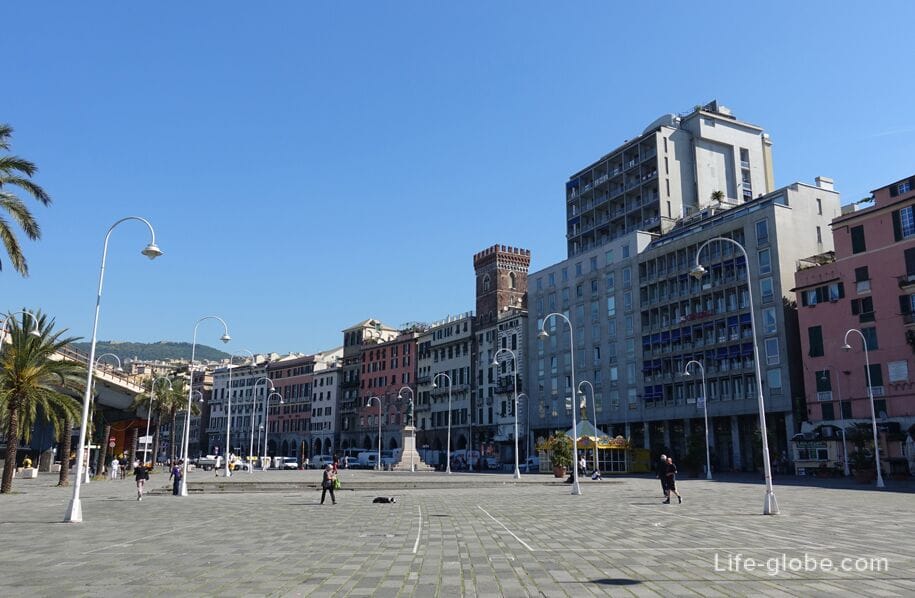
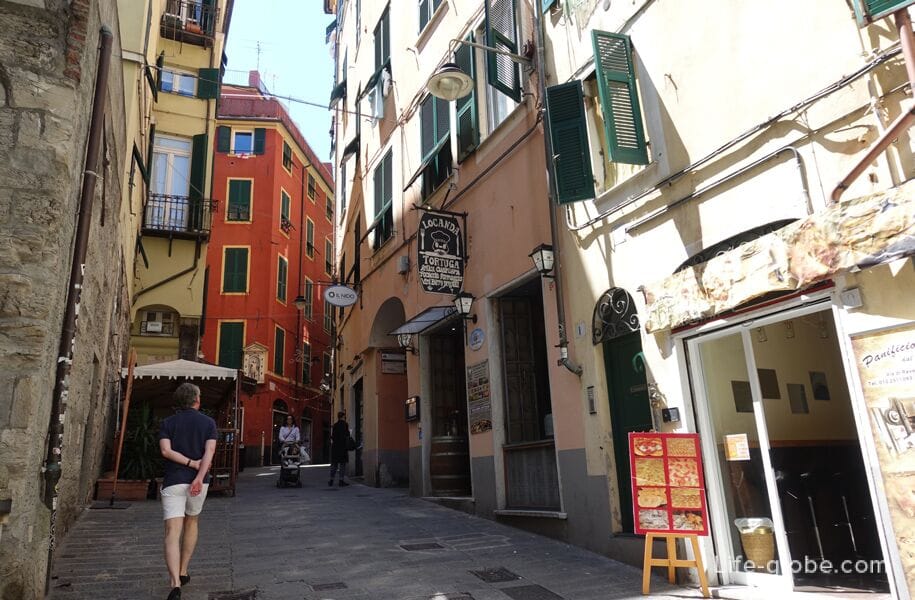
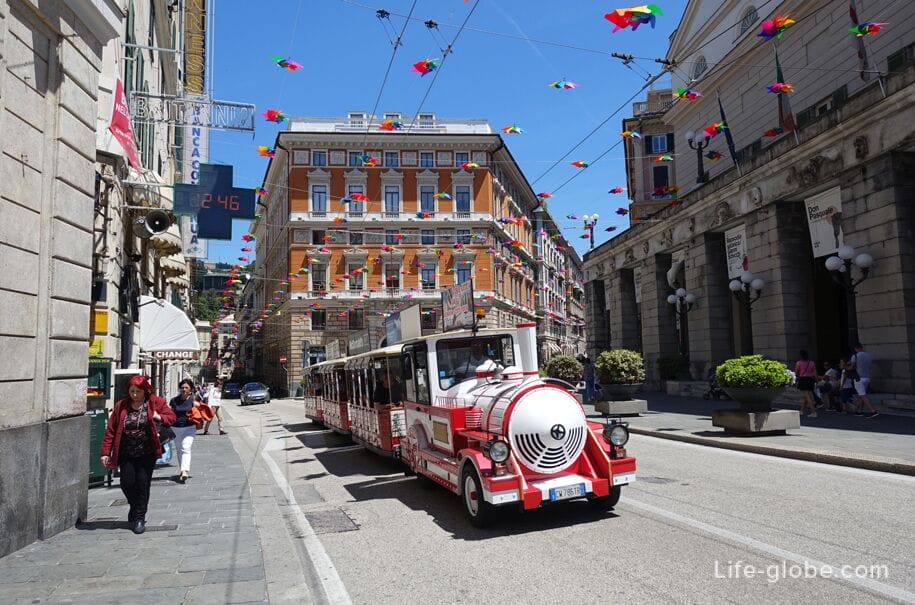
The old port (Porto antico di Genova) with a beautiful wide embankment is part of the large port of Genoa and is used as a marina, residential and tourist center, as well as a place of entertainment and cultural services.
In the port there are: attractions, an aquarium, a botanical garden, a panoramic elevator, museums, a Ferris wheel, places for walking and recreation, where various tourist, musical, cultural and sports events are held.
Also attracting attention is the Lighthouse of Genoa, built of masonry with a height of 76 meters (249 feet) and is the fifth tallest lighthouse in the world. More about the Old Port of Genoa...
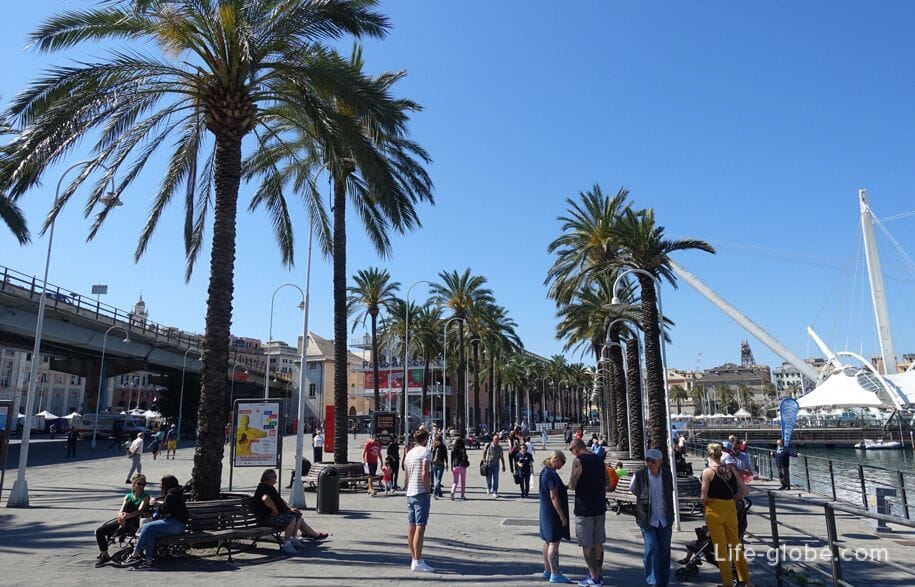


The Old Town of Genoa (also known as the historical center, Centro storico di Genova) is one of the largest and most densely populated historical centers in Europe. Its area is 113 hectares.
Part of the historical center of Genoa is listed as a UNESCO World Heritage Site.
The structure and architecture of the old city of Genoa reflect different eras.
The center of the old town is a maze of narrow streets (caruggi) with small attractive squares and an abundance of attractions. Along the streets, historical buildings rise in dense rows, including churches, cathedrals and former palaces. In some of the historical buildings today there are shops, souvenir shops, cafes, bars, restaurants and accommodation facilities (hotels, apartments)
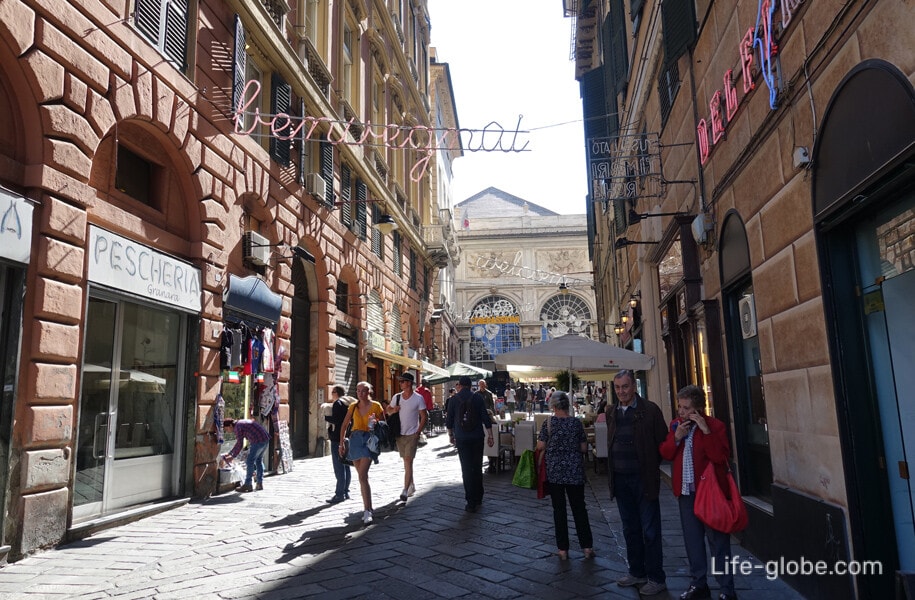
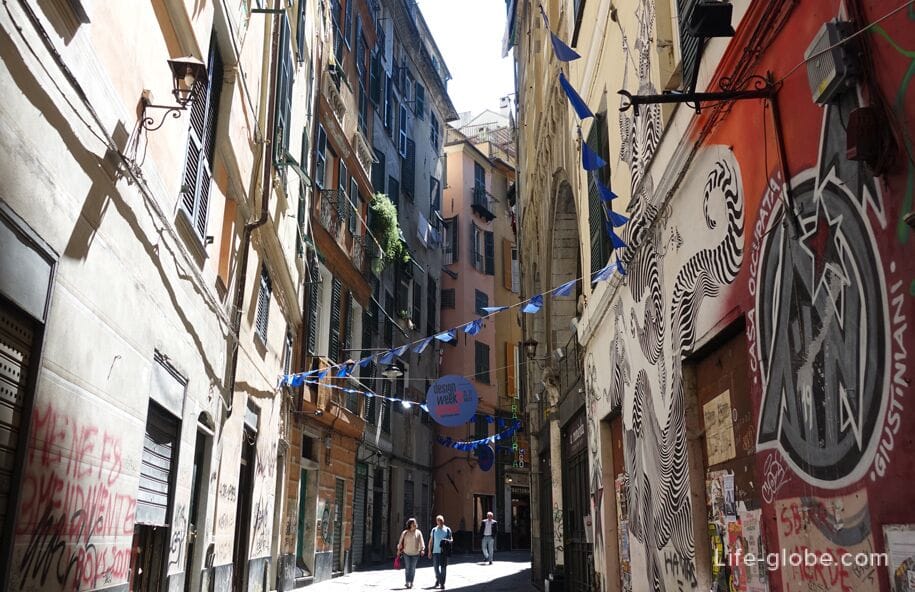
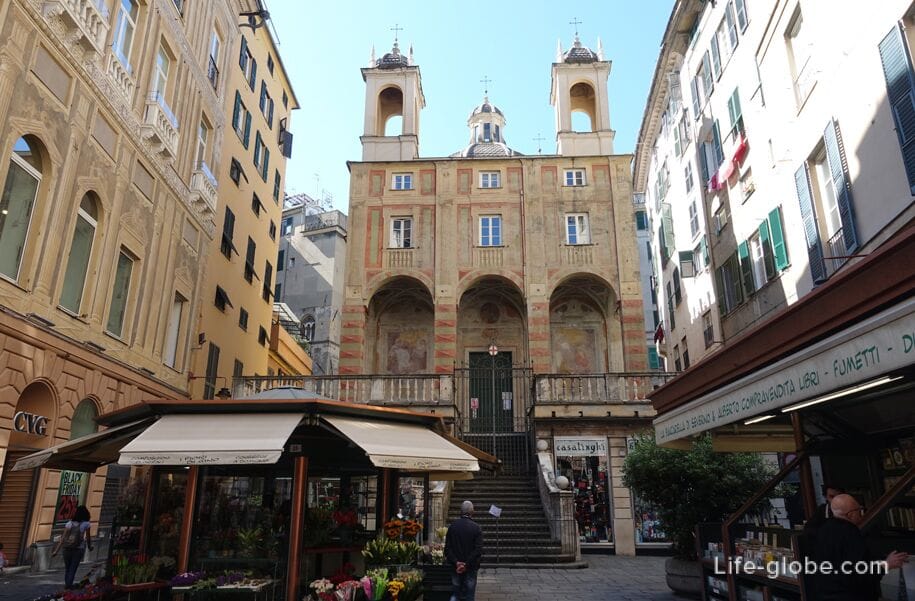
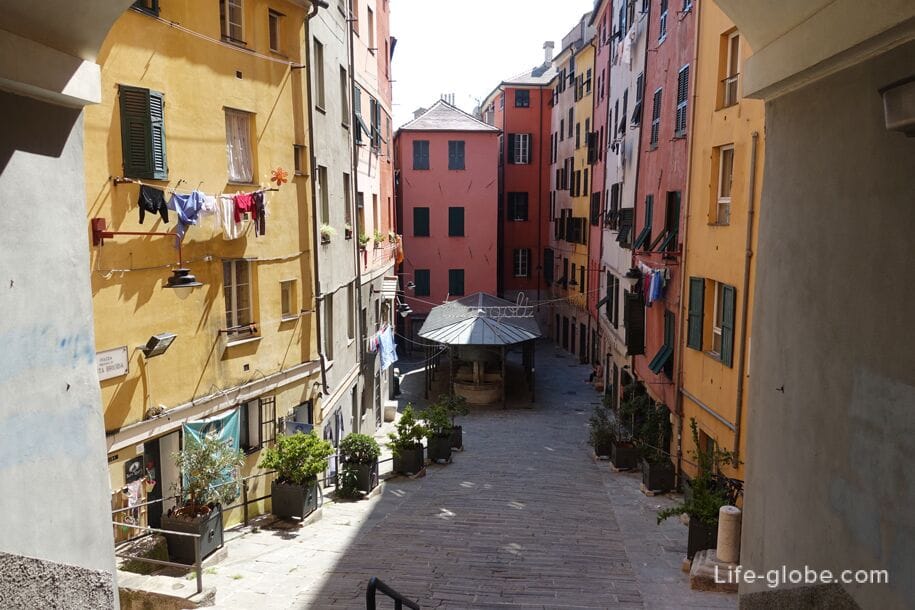
The main attractions of the old town of Genoa include
The Palazzo San Giorgio is one of the most important and, without a doubt, beautiful historical buildings of Genoa, consisting of two parts: the older part - a typical example of medieval civil architecture and the Renaissance bright part facing the sea, with facades completely covered with frescoes.
Currently, the Palazzo San Giorgio houses the administration of the Port of Genoa. Some rooms can be visited. More about the San Giorgio Palace...
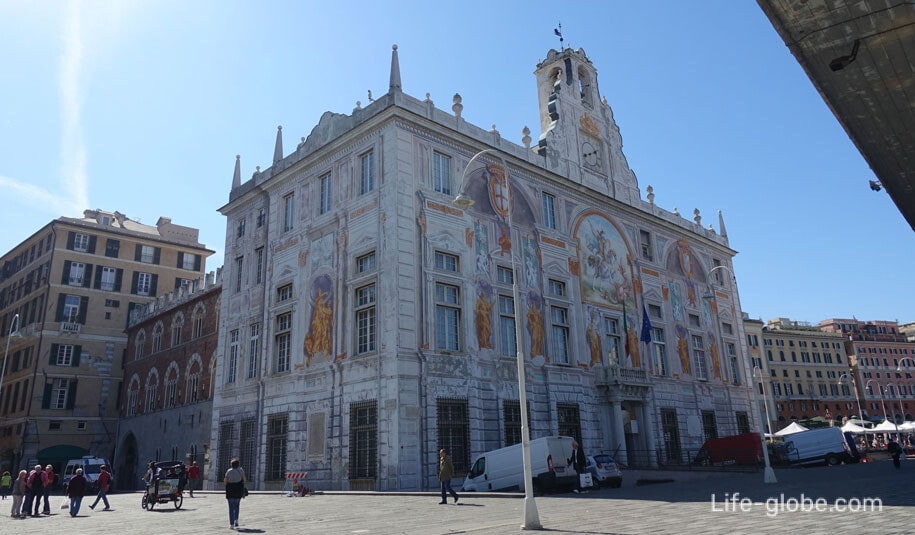
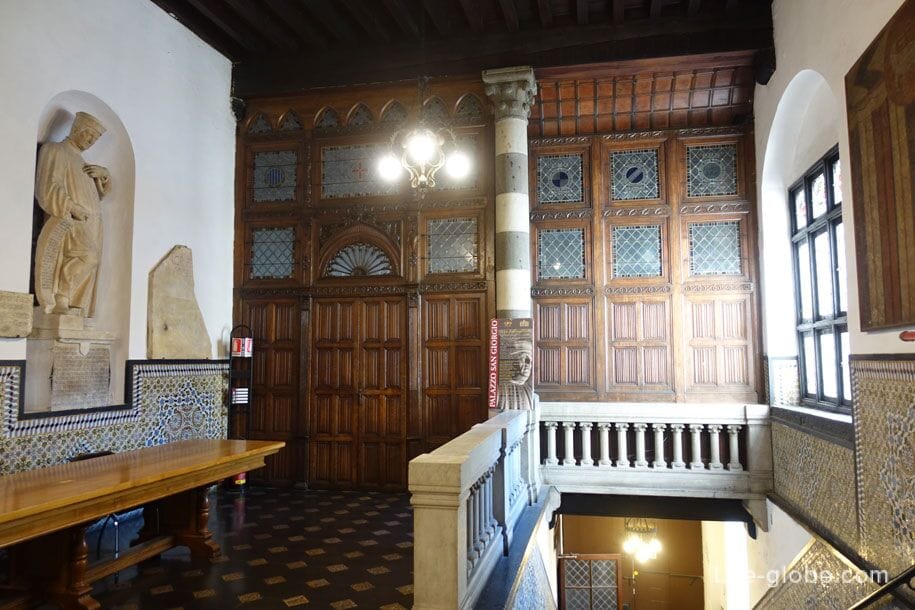
Piazza De Ferrari, which connects the historical center and the more modern part of the city.
The square has an irregular shape due to the union of two adjacent areas, which is also evidenced by the different architectural styles of buildings around the square.
The center of the square has been decorated since 1936 with the most famous fountain of Genoa, designed by architect Giuseppe Croza di Vergagni.
The main buildings around the square are:
- Palace of Liguria (Palazzo della Regione Liguria), formerly known as the Palace of the Italian General of Shipping, built between 1912 and 1923;
- Ducal Palace (Palazzo Ducale), which is one of the main historical buildings and museums of the capital of Liguria, and whose main facade faces the neighboring Giacomo Matteotti Square (Piazza Giacomo Matteotti);
- Teatro Carlo Felice, which is the main Genoese theater and one of the most famous in Italy;
- della Borsa palace or the Palace of the Stock exchange (Palazzo della Borsa / Palazzo della Nuova Borsa Valori) and Credito Italiano Palace (Palazzo del Credito Italiano), erected by Giuseppe Tallero in 1914. Learn more about Ferrari Square...

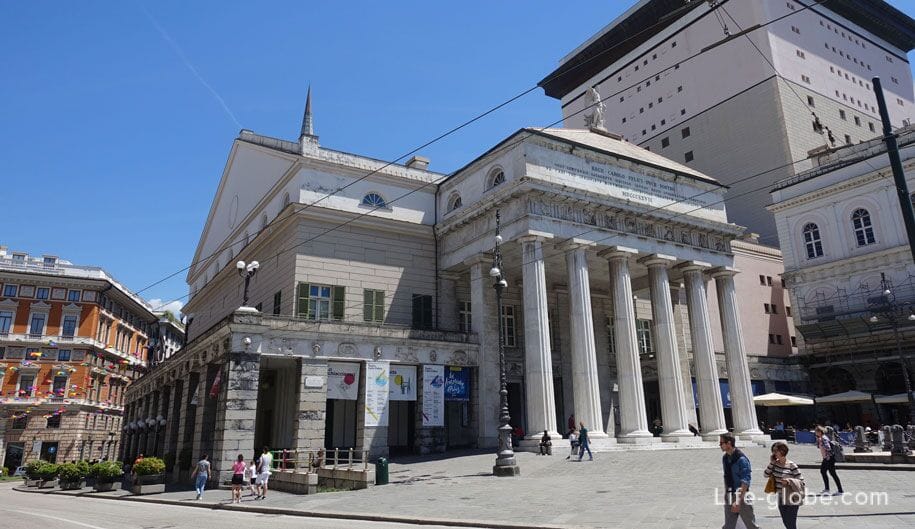


The Cathedral of St. Lawrence (Cattedrale di San Lorenzo, Duomo di Genova), consecrated by Pope Gelasius II in 1118, when the Duomo was not yet completed, and the facade was missing. Between the twelfth and fourteenth centuries, the cathedral was erected and then rebuilt as a fundamental medieval building with some later additions and reconstructions. The full-fledged construction of the cathedral was completed in the 17th century.
Entrance to the cathedral is free (free).
Within the walls of the cathedral, you can visit the cathedral's treasure museum for a fee. More about Genoa Cathedral...
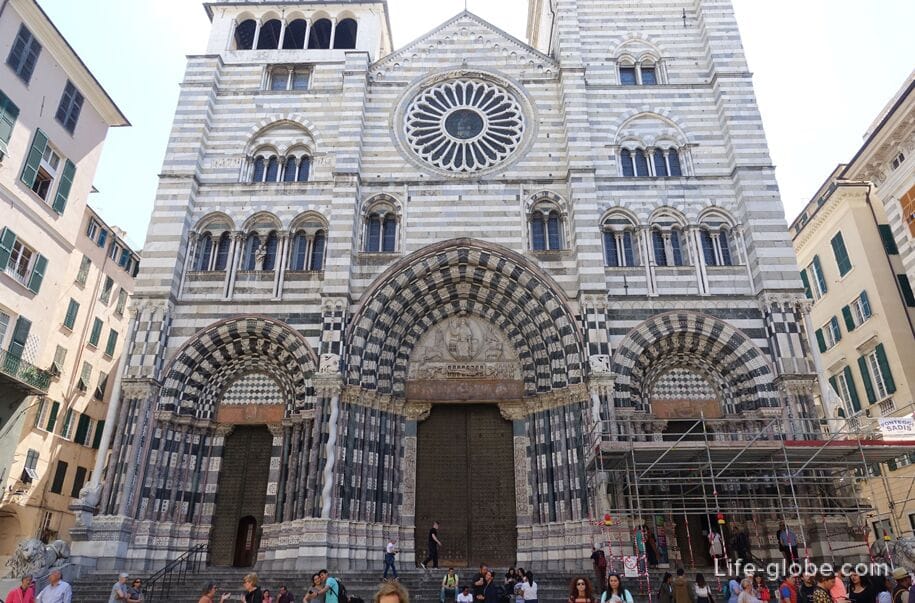
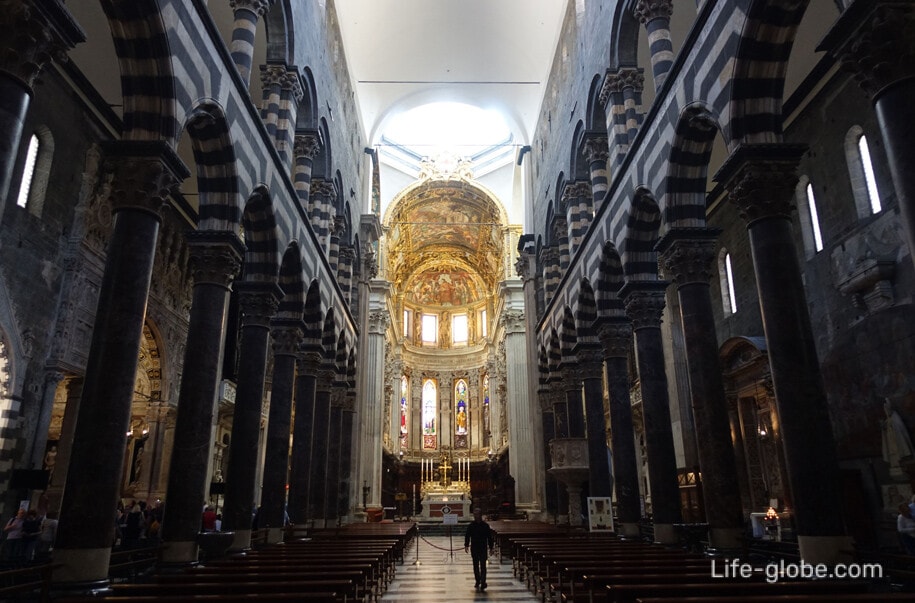
The three most famous streets of the center of Genoa are Via Garibaldi, Via Cairoli and Via Balbi, notable for their luxurious Renaissance palaces, including the Red Palace and Palazzo Reale, which house museums.
Learn more about Garibaldi and Cairoli streets...
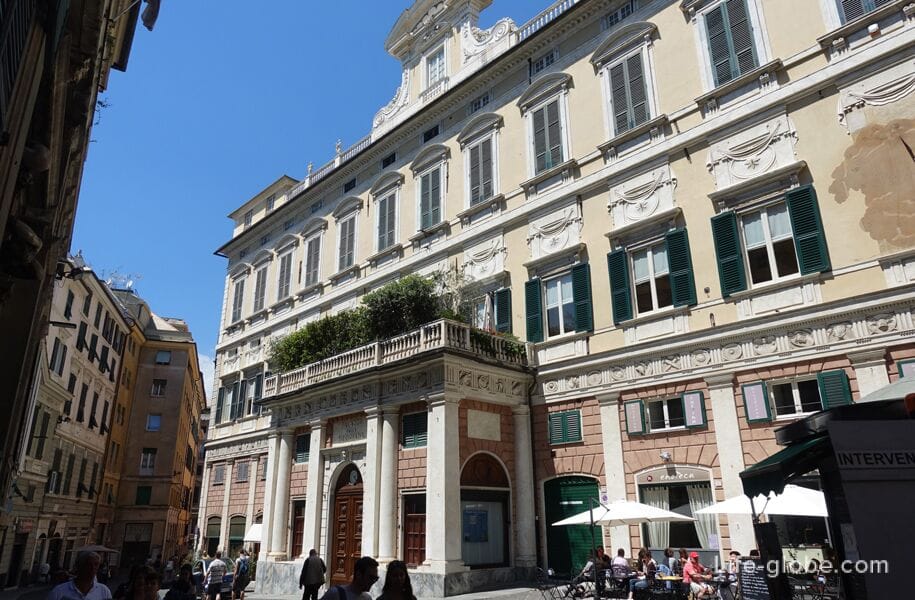
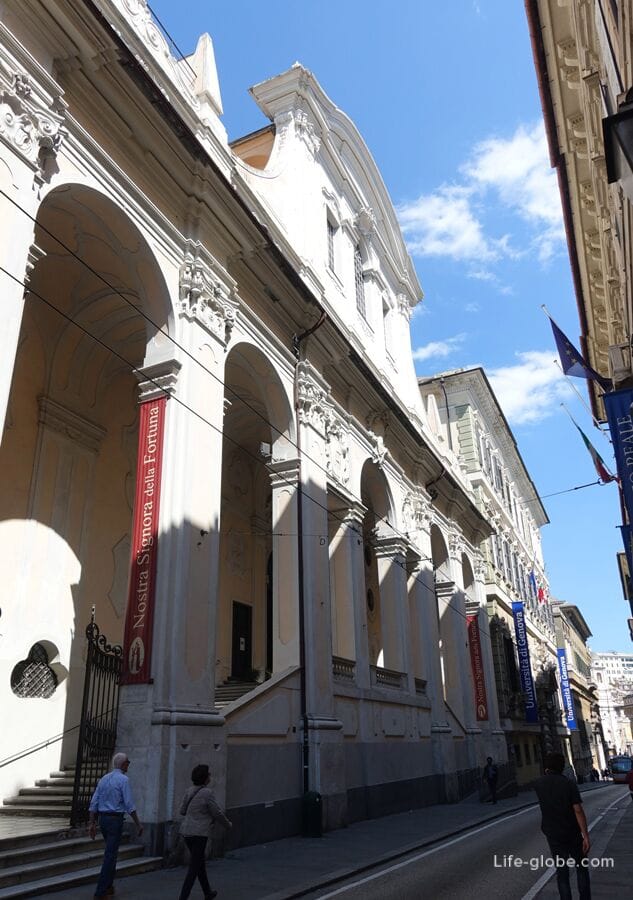
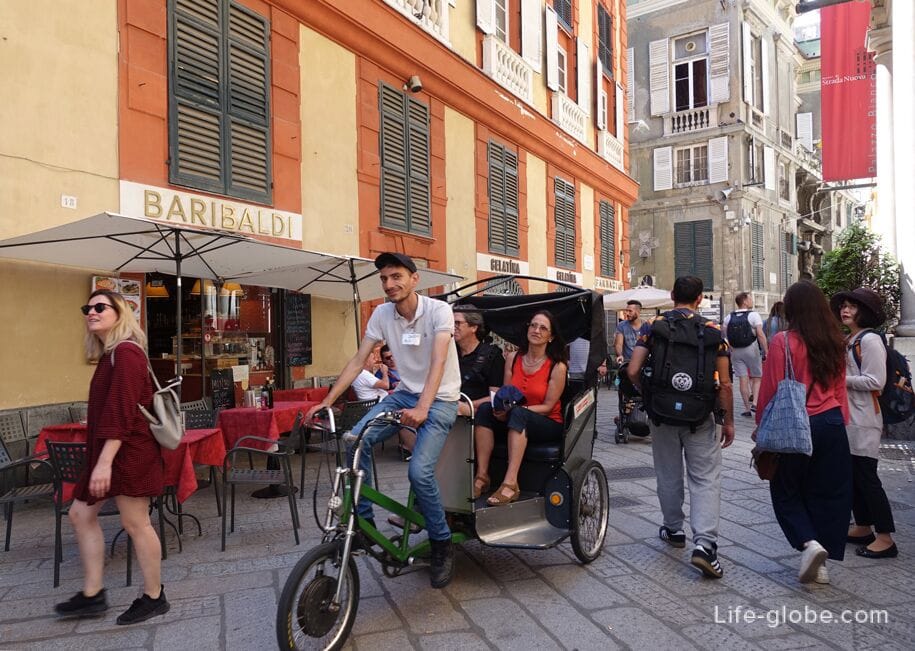
The House of Christopher Columbus (Casa di Cristoforo Colombo), which is a reconstruction of the 18th century, the original medieval building in which Columbus may have lived in his youth.
The building consists of two floors: the first floor was used as the workshop of his father, Domenico Colombo, who was engaged in wool weaving and trade; on the upper floor there was a residential family house. According to written sources, Christopher lived here in the period, approximately, between 1455 and 1470.
Today it is a house-museum, which can be visited both separately and in a complex with other sights of the city. Learn more about the Christopher Columbus House...
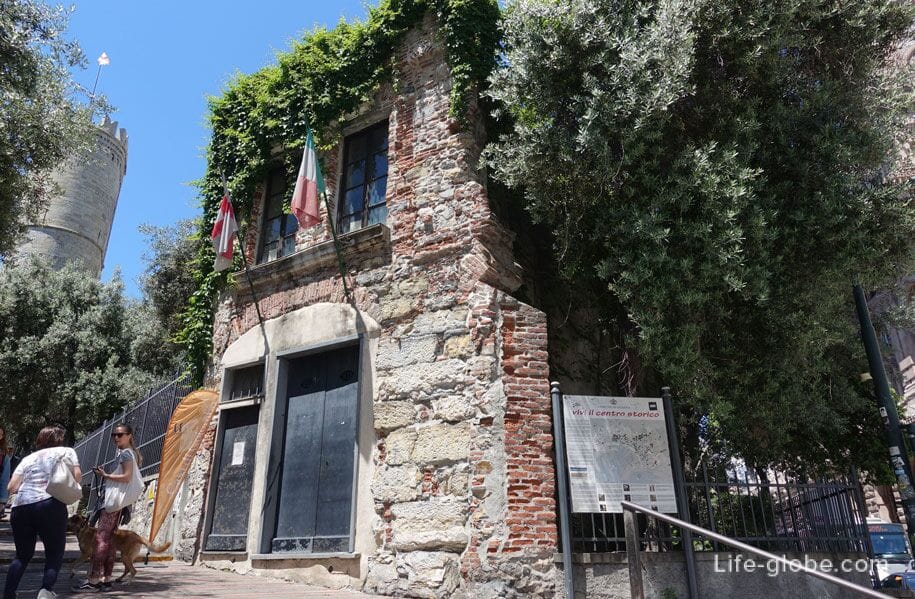
The remains of former fortifications, the most monumental of which are:
- The Sopran Gate or the Gate of St. Andrew (Porta Soprana / Porta di Sant'Andrea, Ligurian name: Pòrta de Sant'Andria) is the best preserved stone medieval gate, part of the second fortress wall of the 12th century.
The port of Sopran can be visited in a complex with other attractions. Learn more about the Sopran Gate...

- the Vacca Gate (Porta dei Vacca), formerly part of the defensive structures of the 12th century and is the entrance gate to the city from the west. More about the Vacca Gate...
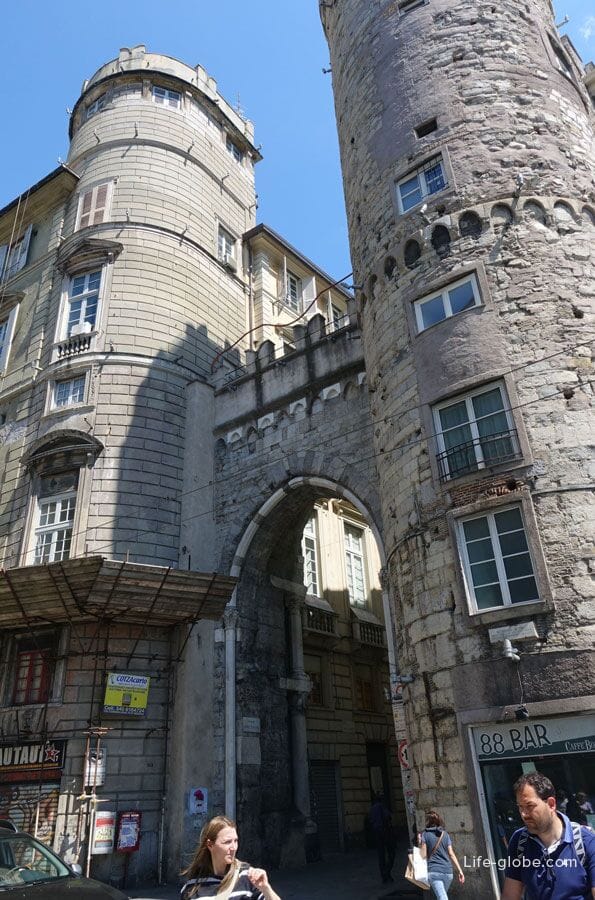
Spinola Palace - nowThe National Gallery (Palazzo Spinola National Gallery), where the works of the greatest Genoese, Flemish and European artists, as well as a collection of ceramics, are presented in the atmosphere of a 16th-century palace.
Website: galleria-nazionale-di-palazzo-spinola.
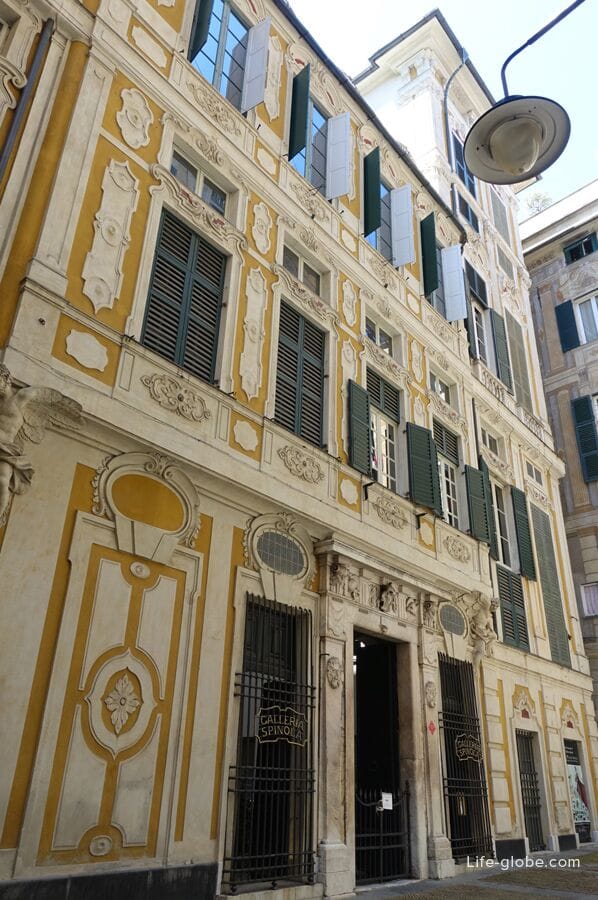
The complex of San Giovanni di Pré (Commenda di San Giovanni di Pré), which is one of the historical gems of Genoa and is a medieval complex of two churches and an ancient hospital.
The current complex was erected, starting in 1180, on the site where there was previously a church dedicated to the Holy Sepulchre, built according to some sources in 636, although the first documentary evidence dates back to 1098.
Today you can visit the historical premises and the church in the complex. More about the complex...


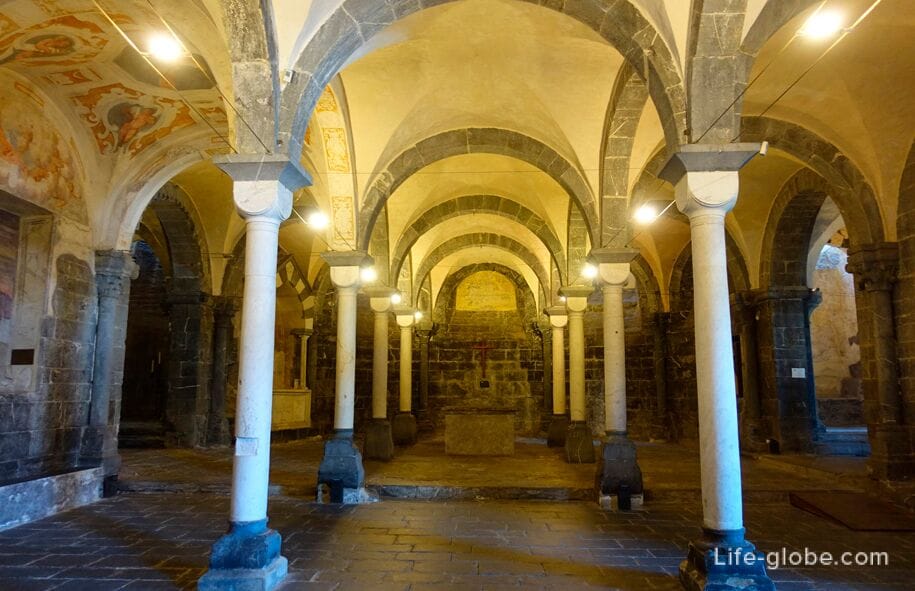
Villa del Principe, also known as the Princely Palace or Palazzo di Andrea Doria (Paxo do Dria Doria) is the largest and most luxurious noble residence in the center of Genoa, built as a private country mansion that belonged to several generations of the Doria Pamphili family, originally the Genoese admiral and statesman Andrea Doria.
A small garden adjoins the villa.
Of particular interest is the interior of the villa, which has preserved frescoes with mythological themes and tapestries, as well as a monumental staircase. More about Villa Principe...
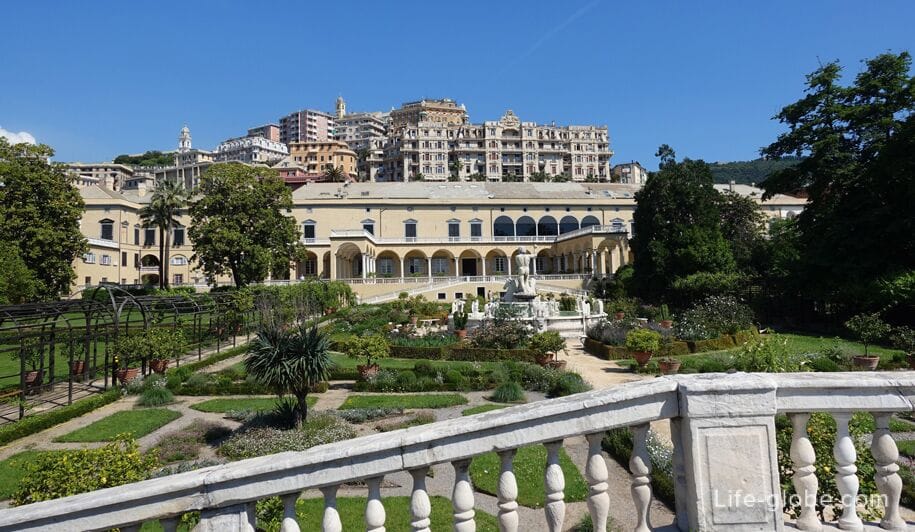
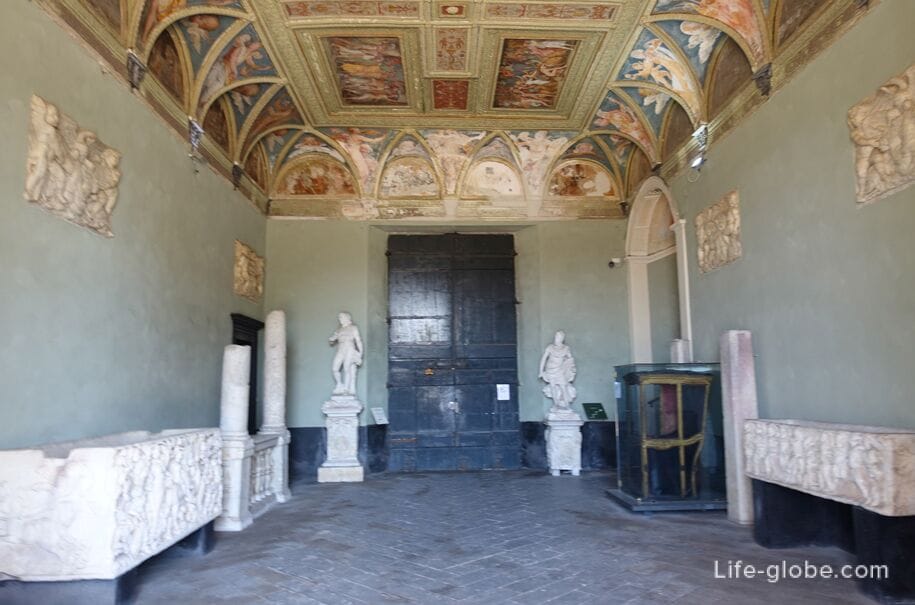
Near the railway station of Principe (Genova Piazza Principe), on the square Acquaverde (Piazza Acquaverde) stands the monument to Christopher Columbus (Monumento a Cristoforo Colombo). Learn more about the historical center of Genoa...

The 20th of September Street (Via XX Settembre) is one of the main streets of the center of Genoa and the main artery of the commercial district of the city.
The length of the Via on September 20 is about 850 meters.
There is a driveway along the street and sidewalks on both sides of it. Portico buildings, on the ground floors of which boutiques, shops and cafes are located, attract neo-Renaissance style with intricate decoration of facades, massive projecting balconies, pilasters and decorated windows. More about the street on September 20...
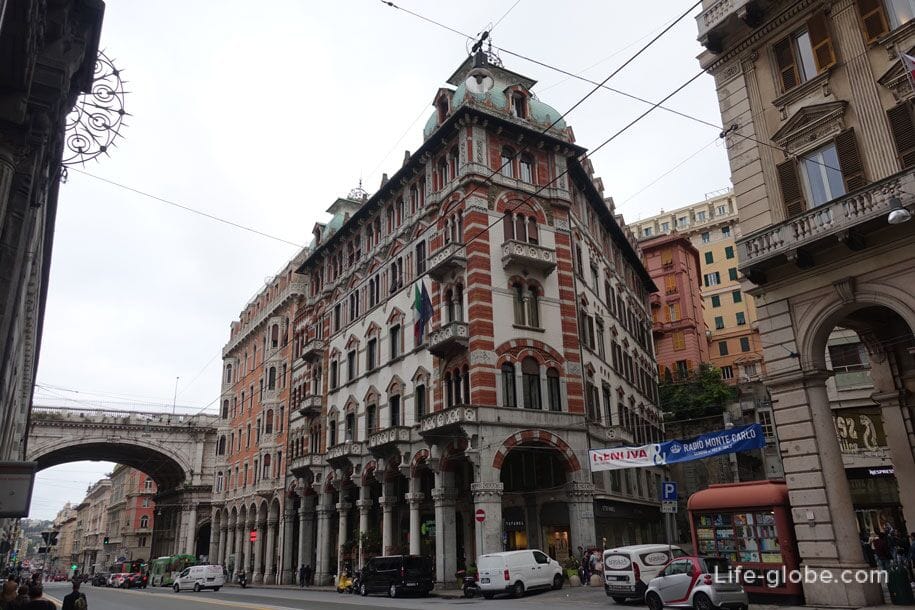
Victory Square (Piazza della Vittoria / Piazza Vittoria) is one of the central and largest squares of Genoa.
The center of the square is decorated with the monumental Victory Arch (Arco della Vittoria), which is a memorial arch dedicated to the Genoese who died during the First World War. More about Victory Square...
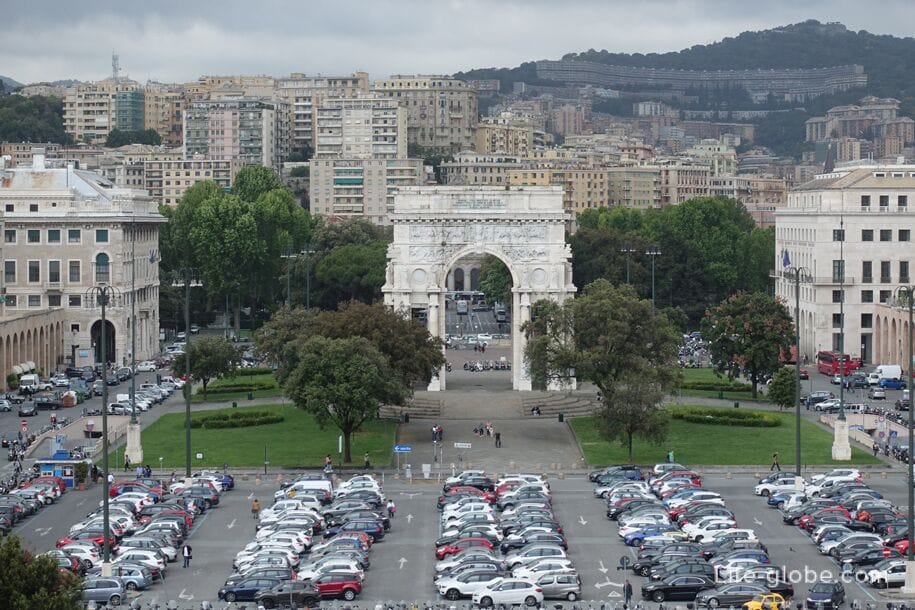
Near Victory Square there is the staircase of the Unknown Soldier or the staircase of the Caravels (Scalinata delle Caravelle), climbing the green slope of the Carignano hill (Carignano).
The intervals of the flights of stairs are decorated in the form of flower beds.
From the top of the stairs there are wonderful panoramic views of Victory Square and the surrounding area.

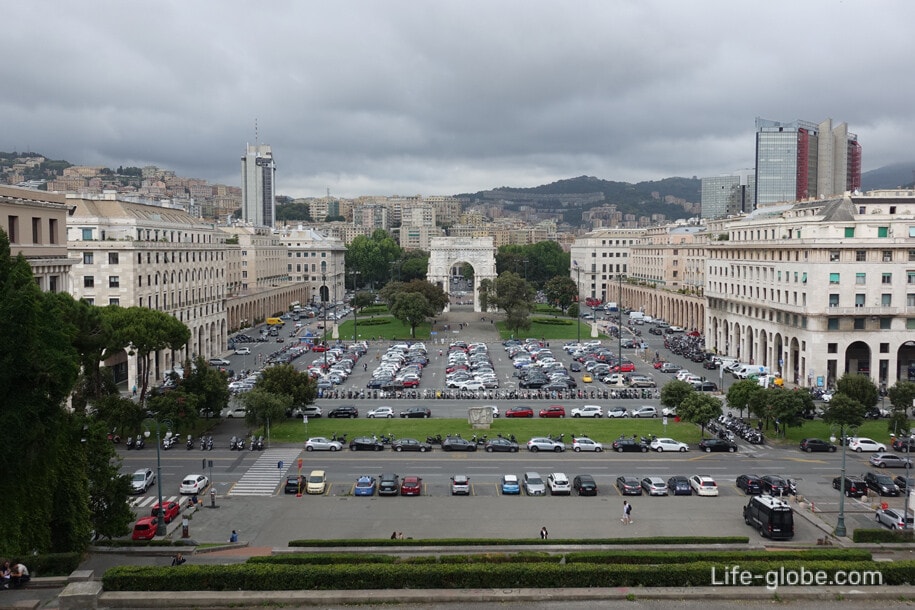
On the hill of Carignano there are churches (of which the Basilica of Santa Maria Assunta in Carignano stands out / Basilica di S. Maria Assunta in Carignano), as well as Villa Croce, which now houses the Museum of Modern Art (Villa Croce Museum of Contemporary Art) with a permanent collection of Italian and international contemporary art.
Villa Croce in its current form was rebuilt in neoclassical style in the 19th century for Giovanni Giacomo Croce, transforming a previously existing 17th-century villa owned by the Spinola family. In 1951, the villa was donated to the municipality for conversion into a museum.
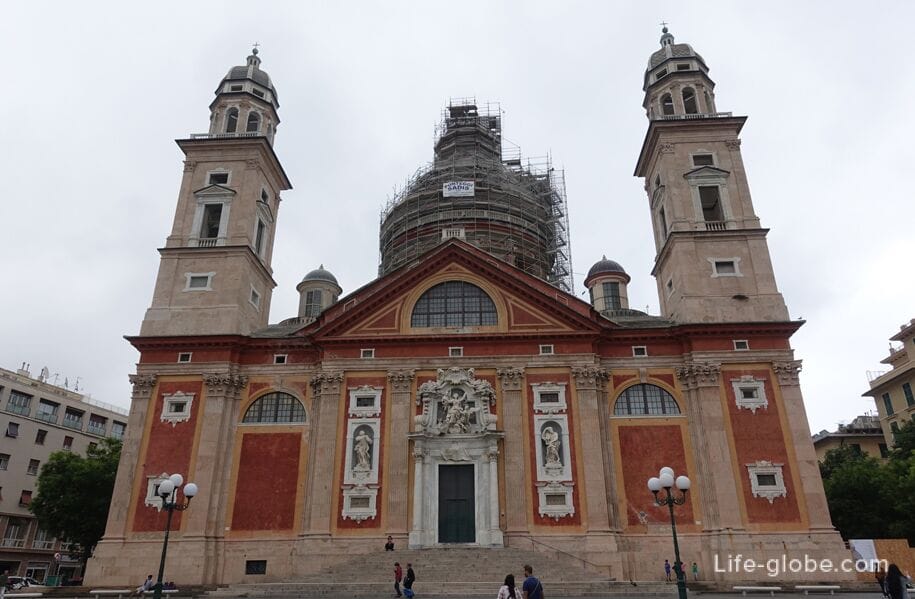

From the hill of Carignano, you can enjoy views of the port and the sea.

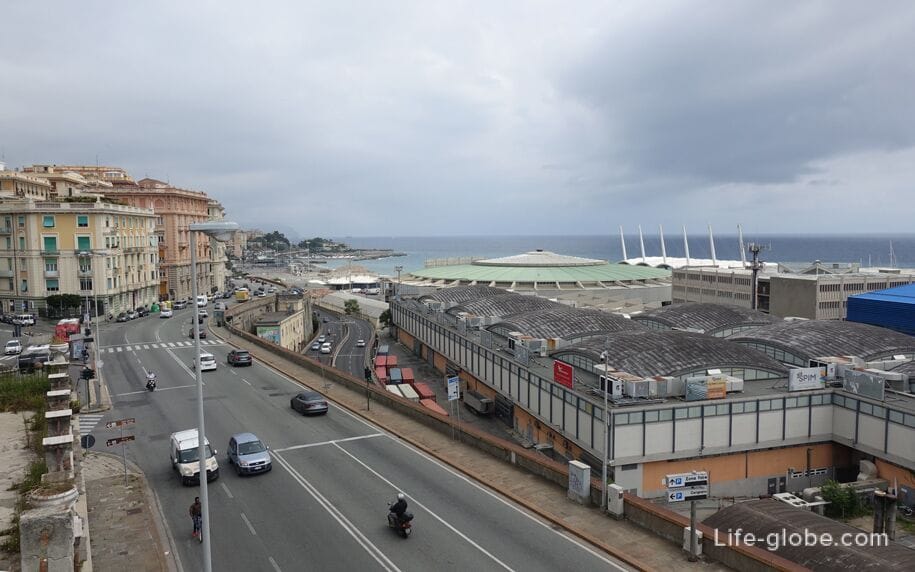
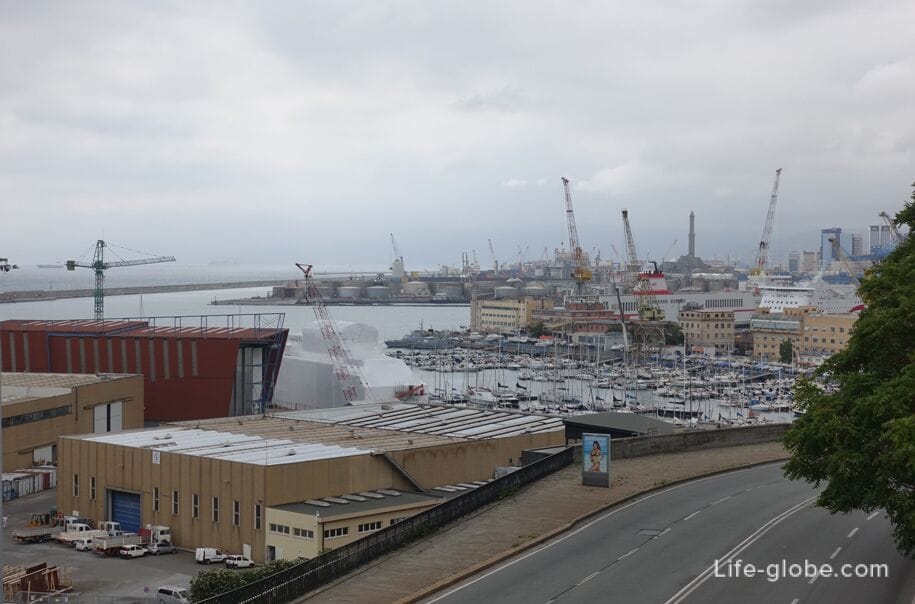
Since Genoa is located on the hills, from some points of the city there are panoramic views of the city itself and the Gulf of Genoa.
The main part of the panoramic viewpoints is located on the hills outside the old town of Genoa.
A popular observation deck-terrace near the historical center is located in the Castelletto quarter, which occupies a hilly area that was outside the city before the construction of New walls in the 17th century. The observation deck (Spianata Castelletto) is especially popular in the quarter, located on the site of the dismantled fort and with a view of the Old Town and the Gulf of Genoa.
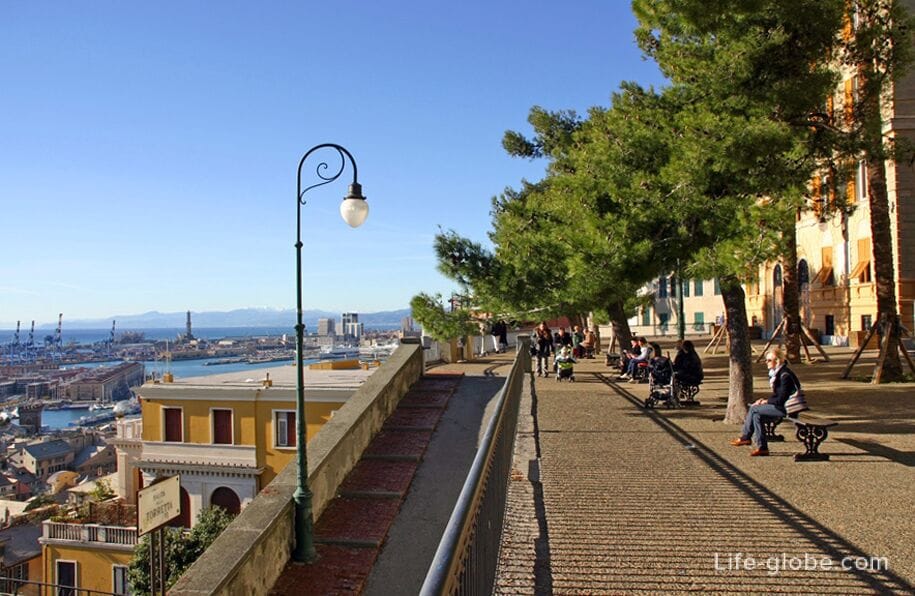
The Castle d'Albertis (Castello d'Albertis) is a historical residence that originally belonged to the sea captain Enrico Alberto d'Albertis.
The castle was built between 1886 and 1992 on the ancient walls of the bastion of the 13th-14th centuries, which were fortified in the 16th century. The castle partially absorbed the remains of an ancient wall and one of the towers.
The Castello Albertis was built in the Gothic Revival style.
Currently, the Museum of World Cultures (Museo delle Culture del Mondo) is located within the walls of the castle.
The castle is surrounded by a public park area. More about the castle and the museum...

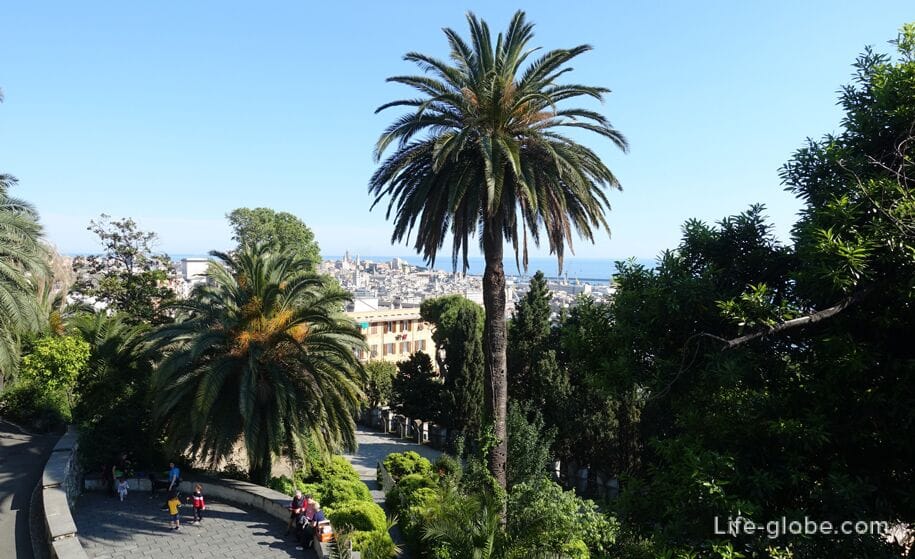
The Castle of Bruzzo (Castello Bruzzo) stands on a hill overlooking the port of Genoa and the sea.
Designed in 1904 by Gino Coppede, the castle looks impressive. It consists of four floors with a high tower - partly crenellated and partly with sloping roofs in a combination of stone, red brick and white concrete parts. The loggia in the south is decorated with frescoes on the arches with allegories and zodiac signs inside panels with stylized floral motifs.
The castle is surrounded by a park, which is an elaborate composition of paths, views and elemental decorations, and access is via a suspension bridge over the moat.
Today the castle has several halls and there is a restaurant with a panoramic terrace.
Restaurant website: castellobruzzo.
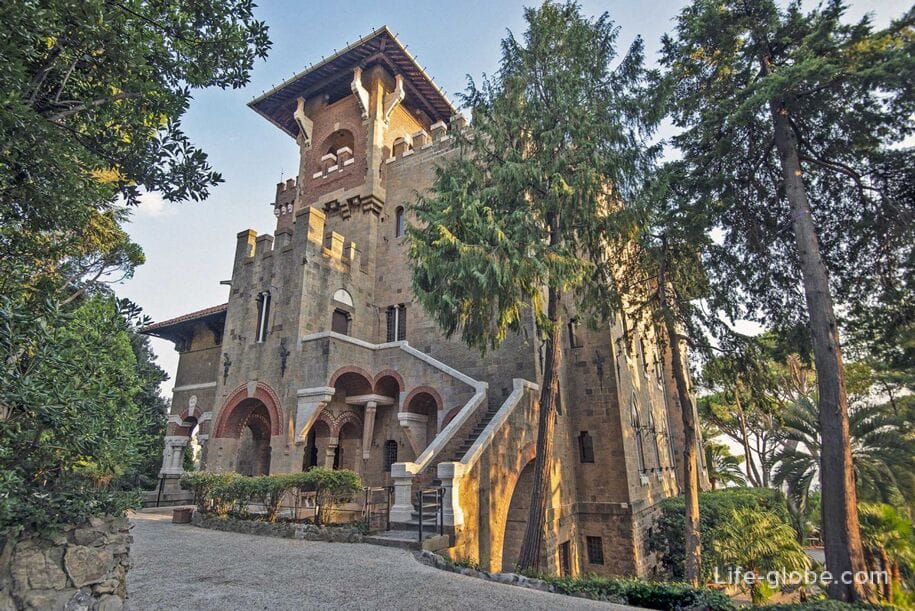
Castle Mackenzie (Castello Mackenzie), another estate in the Gothic Revival style.
The castle was built in 1893-1905 by architect Gino Coppede on a previously existing country villa located on the site of the Genoese walls of the 16th century.
The estate was opened to the public in 2004 and is now used as a public place for scientific or cultural exhibitions.
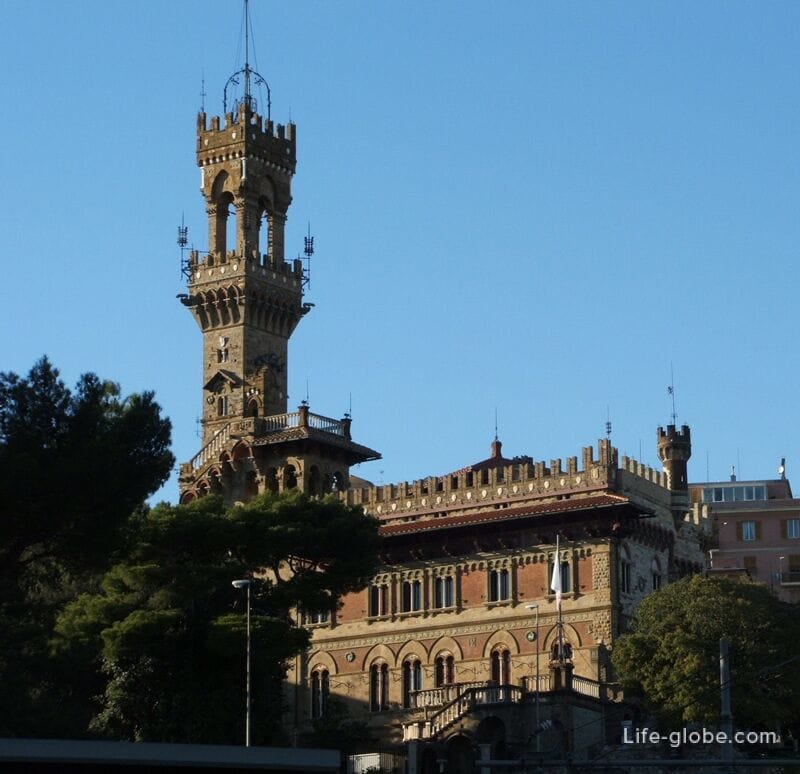
The monumental Cemetery of Staglieno (Staglieno Cimitero Monumentale) is one of the most famous cemeteries in the world and occupies a hillside on the outskirts of Genoa.
The cemetery is famous, first of all, for a large number of highly artistic marble tombstones made by notable Italian sculptors of the late 19th century - Santo Varni, Giulio Monteverde and others.
The history of the cemetery dates back to the time of the occupation of Italy by the army of Napoleon, who in 1804 ordered for sanitary purposes to take out all cemeteries outside the city walls. In Genoa, the project of a monumental cemetery was developed by the city architect Carlo Barabino in 1835. In 1872, the funeral of the national hero Giuseppe Mazzini attracted the attention of the whole of Italy to the cemetery; a separate mausoleum was erected over his grave. With the increase in the number of burials, Anglican, Protestant and Jewish sections were allocated.
By the end of the 19th century, the necropolis was considered one of the main attractions of the city.
Website: staglieno.comune.genova.
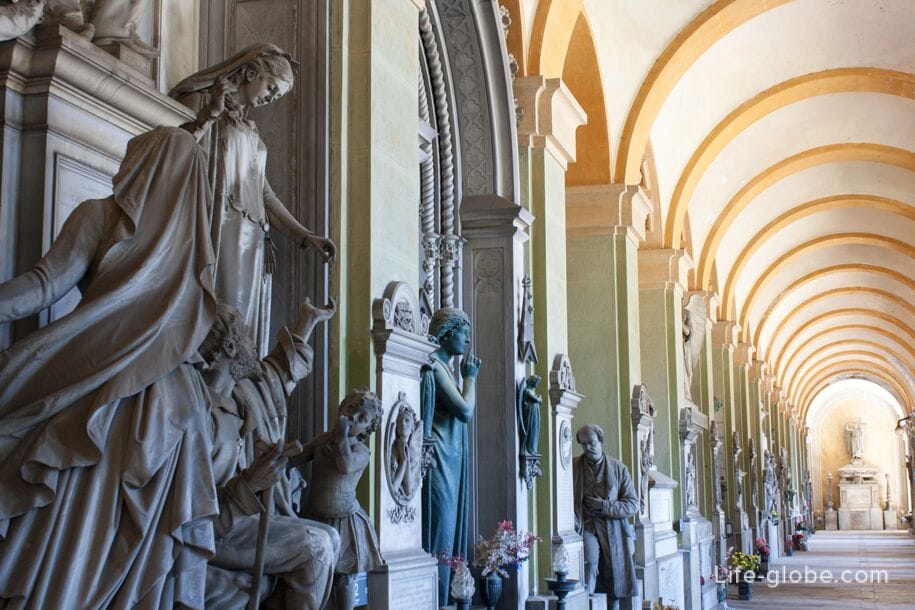
On the northern outskirts of the city, on the hills, there is a large natural city park of walls and forts (Parco Urbano delle Mura e i Forti), which is located in the area of the New Walls of the city, erected at the end of the 17th century.
The park includes 617 hectares, on which, in addition to the walls, there are several forts built between the seventeenth and nineteenth centuries.
The park is home to some species of animals and plants that are protected as rare or endemic.
The classic route through the park starts from the upper terminus of the funicular Zecca-Righi and runs in the direction of Fort Castellaccio (Fort Castellaccio) and Sperone (Forte Sperone); from here you can enjoy a panoramic view of the city. Then the path can continue in the direction of Forte Begato (Forte Begato) of the nineteenth century, or go deeper to get to the small Forte Puin and Forte Diamante, located at an altitude of 660 meters above sea level and offering stunning panoramic views.
The route crosses pastures, meadows, forests, ruins of the rural and pastoral past. There are also deviations from the main path that allow you to vary the visit to the park according to individual interests and time.
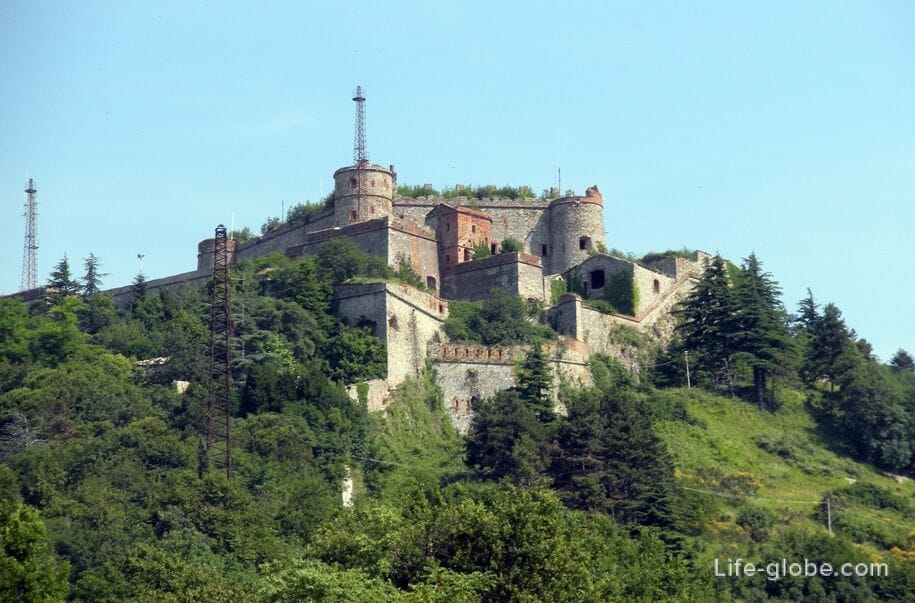
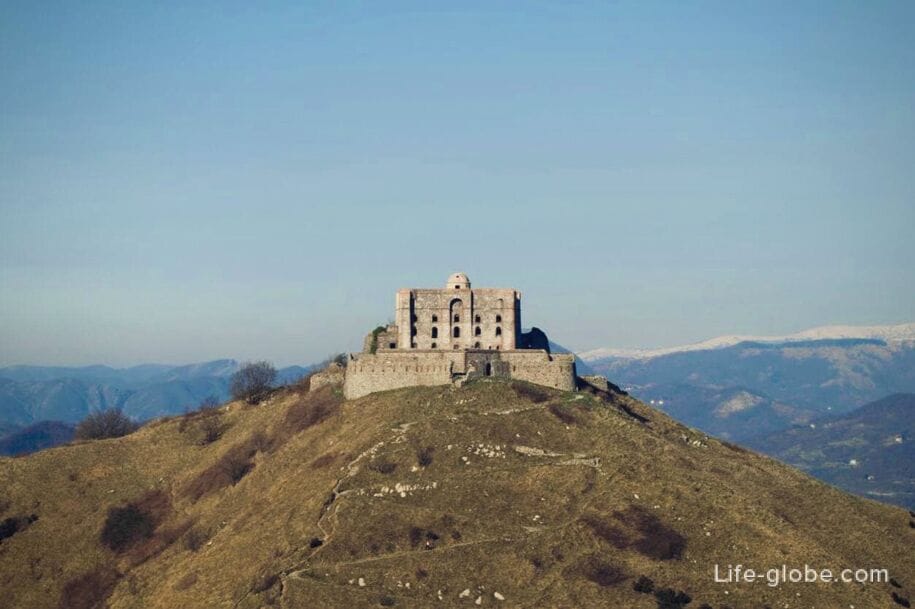
Along the sea line, in the east and west direction of Genoa, small residential and tourist areas (former autonomous municipalities) alternate, in which there are beaches, some attractions and each of which is good in its own way.
The best beaches of Genoa, as well as embankments with panoramic views are located in the east direction from the center of Genoa.
The eastern part of the coast of Genoa originates just outside the port and runs to the town of Bolasco. It consists of 7 districts:
- Foce, where the main embankment of Genoa originates - Corso Italia, which runs along the coast of the Albaro district to the ancient fishing village of Boccadasse;
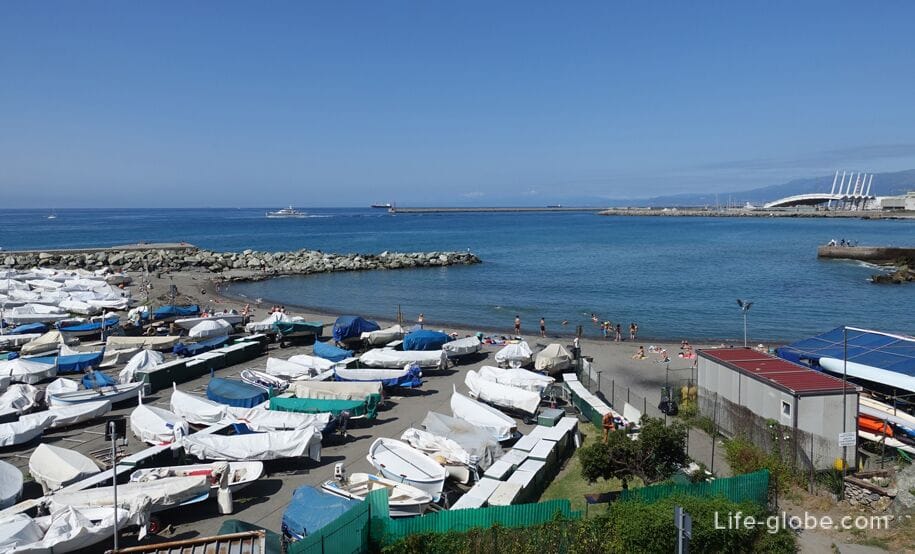
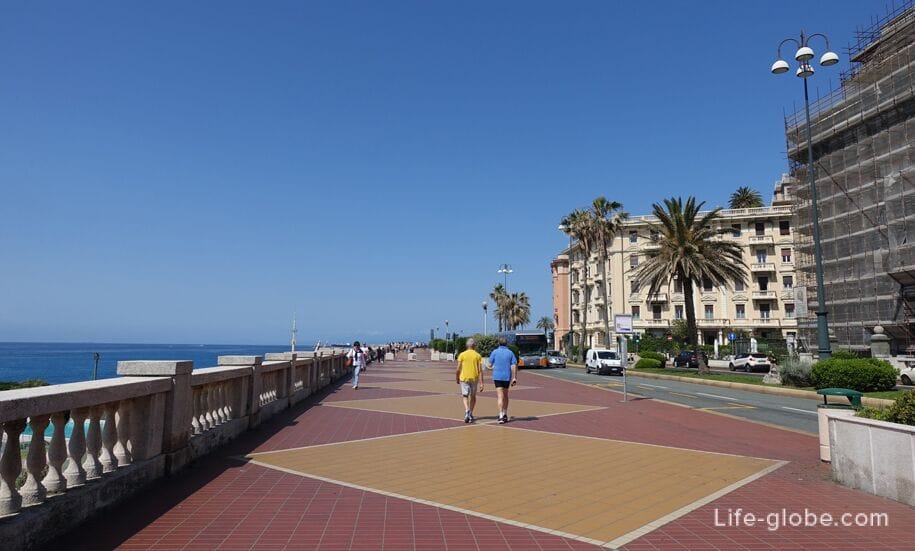
- Albaro, famous for its beaches, the bulk of which are paid beach clubs with all the necessary infrastructure.
A separate part of the Albaro district stands out Boccadasse is a small historical fishing village and one of the most charming and visited places of the Genoese coast;



- Sturla, the coast of which is characterized by the presence of two picturesque beaches: Vernazzola and the beach of the same name Sturla.
Also in the area stands out the castle Turcke (castello Türcke) in the style of an eclectic, which is a building of the early 20th century (1903), stylized as a small castle;
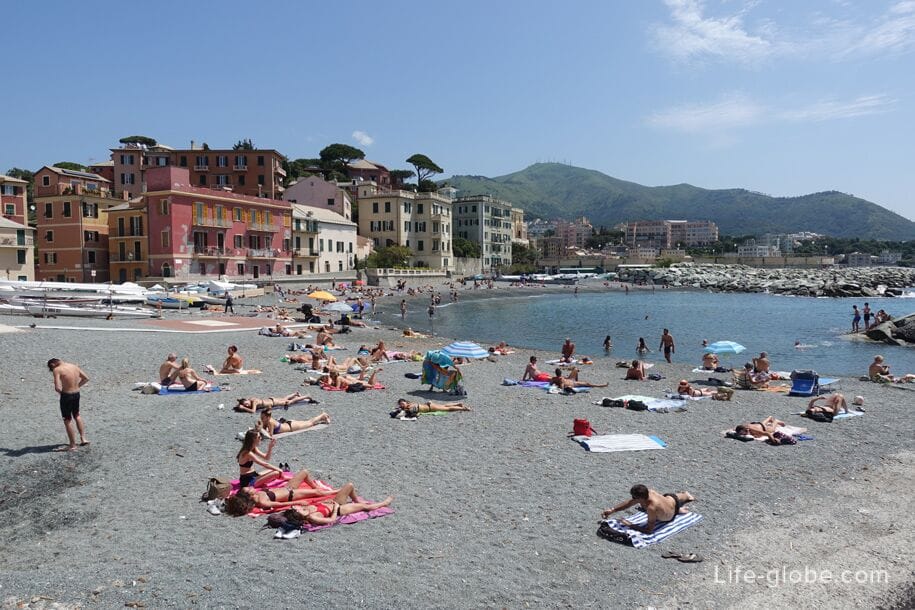
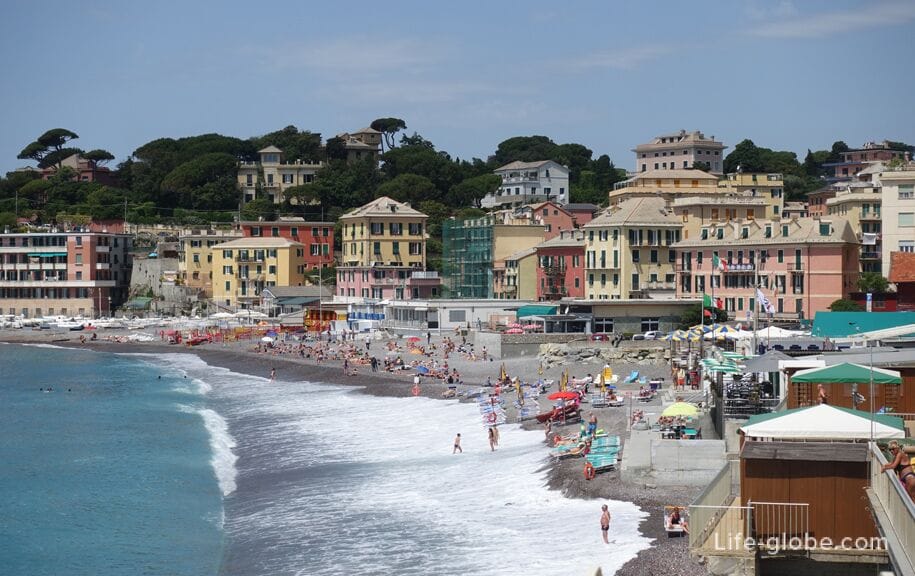
- Quarto dei Mille, the coast of which is indented by coves surrounded by rocky and rocky formations.
In the Quarto area are notable: religious architecture (churches and an abbey), villas whose structure dates back to the 14th century, as well as the CUS Genova Golf Academy Golf Club and a small children's amusement park Magic Zena;


- Quinto al Mare, the coast is similar to the Quarto area, but less extended;
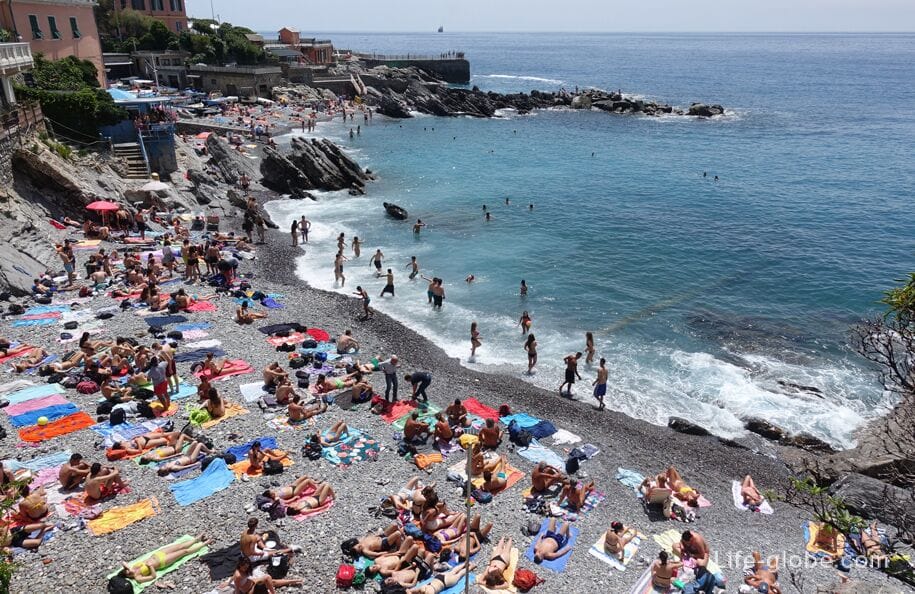
- Nervi, unofficially considered a resort, with its particularly mild climate and is one of the most popular and extended areas in the vicinity of the center of Genoa.
Notable in the area are: the port of Nervi, which is a small harbor surrounded by buildings of characteristic Ligurian architecture, painted in bright colors; the Anita Garibaldi embankment (passeggiata Anita Garibaldi), running along the sea line along a long cliff to the eastern tip of the Nervi district.
The area is also notable for several gardens and villas;
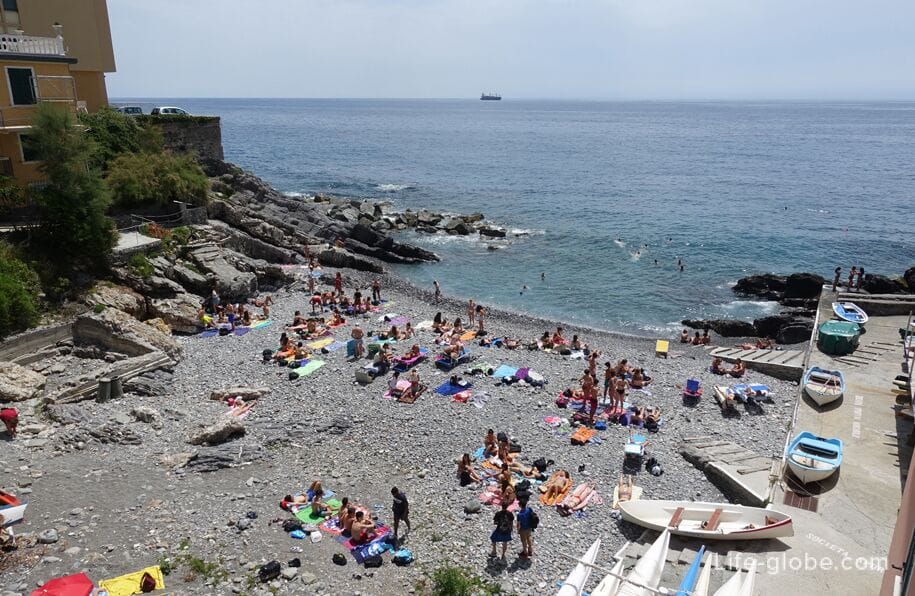
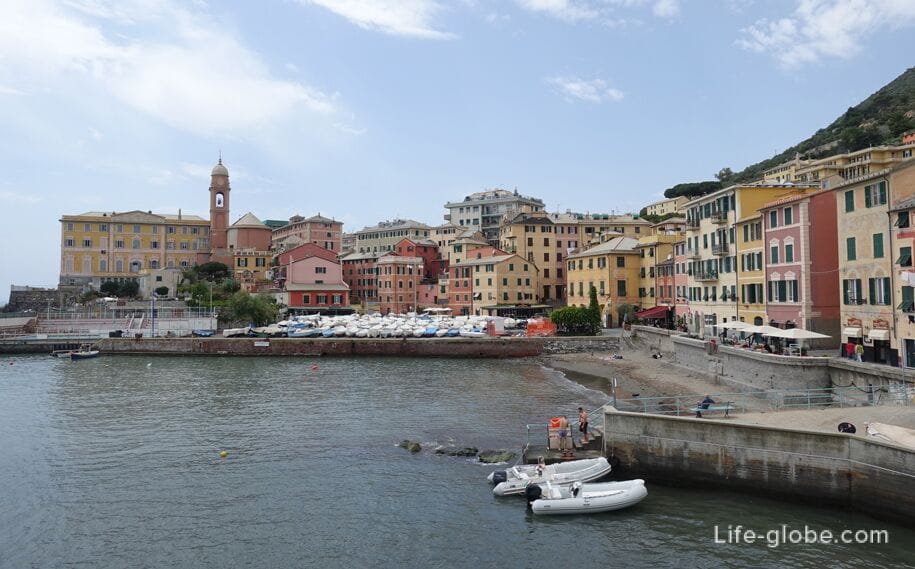
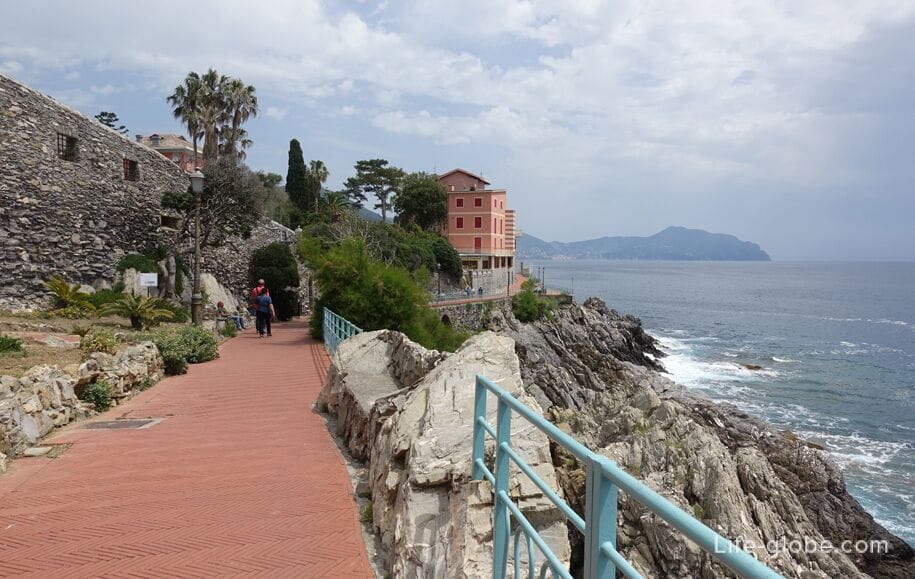

- Sant'Ilario is the last eastern district of Genoa.
The coast of Sant Ilario is characterized by rocky formations with a minimum of beaches.
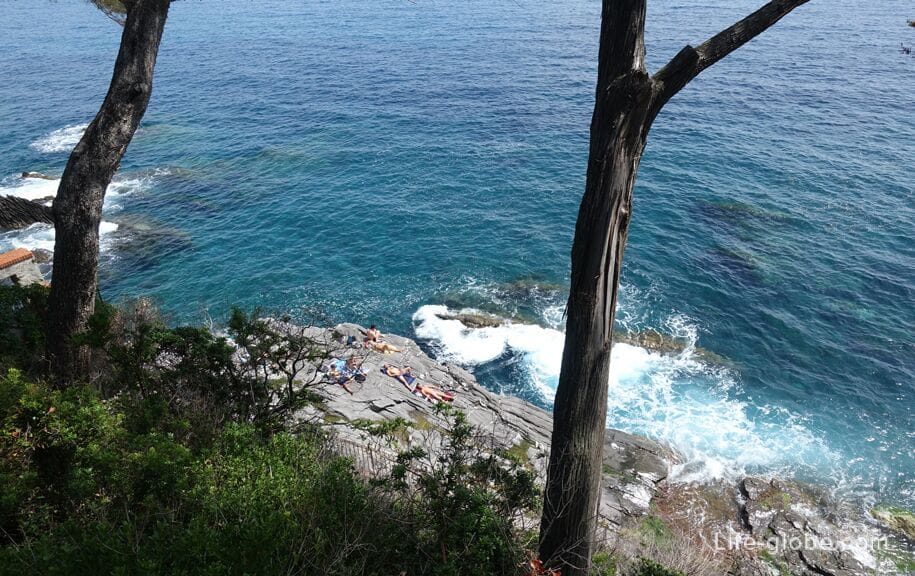
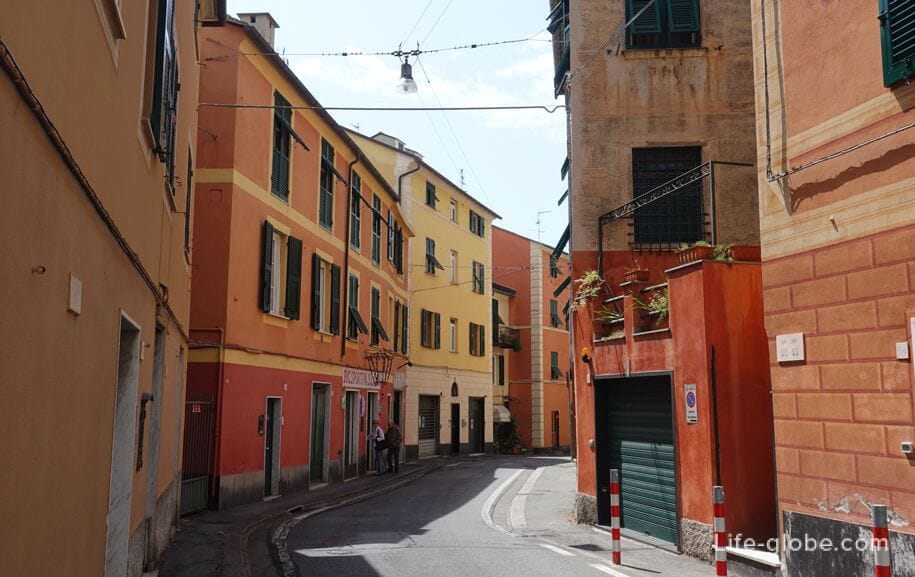
The western part of the coast of Genoa not as attractive as the eastern one. There are three districts here:
- Peli or Pegli - one of the most picturesque and interesting areas of Greater Genoa with beaches and a beautiful promenade.
In Pegli, Villa Durazzo Pallavicini is a remarkable historical ensemble consisting of a villa and an adjacent park. Today it is a museum;
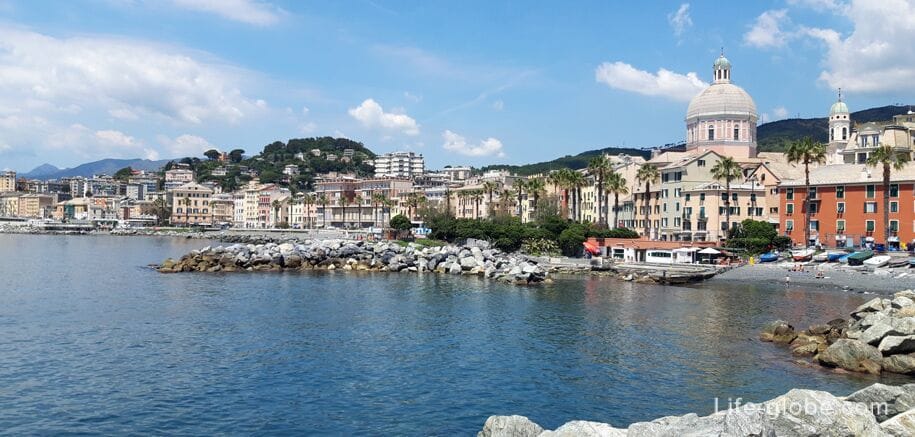
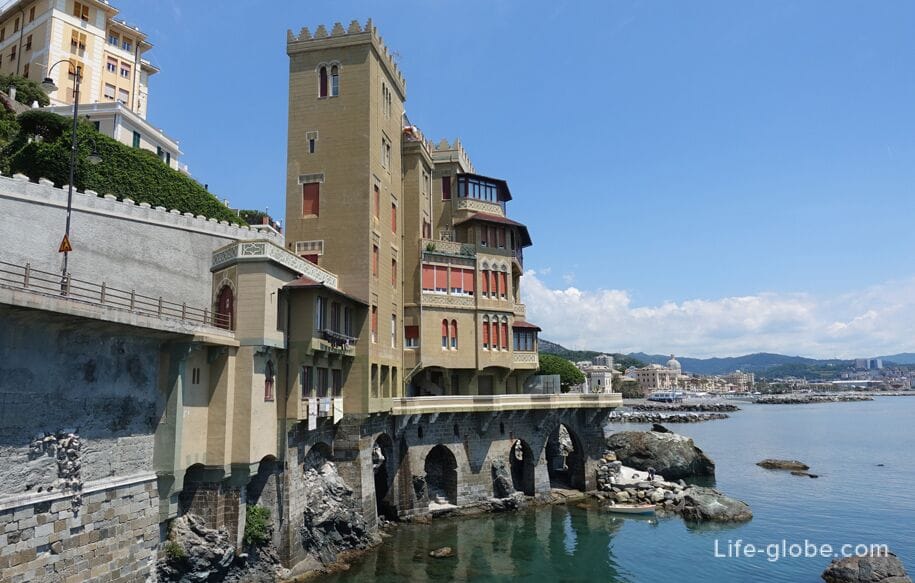
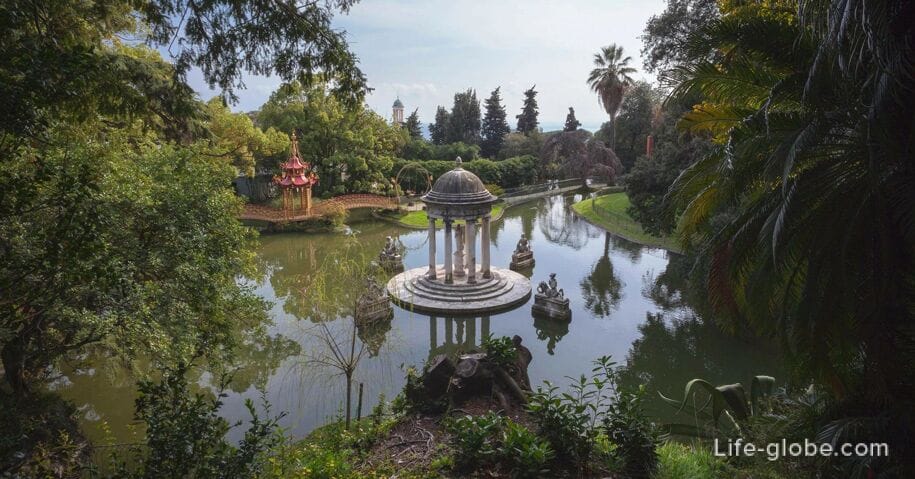
- Pra (Pra') is the central area of the western part of the coast of Genoa.
Although Pra is located along the coast, there are no beaches in the area. The coastline in this part of Genoa is occupied by the port and yacht zones;


- Voltri - the last of the areas of the western part of the coast.
In the center of Voltri there are two beaches, apparently distributed and named after the names of two large churches located near the beaches.
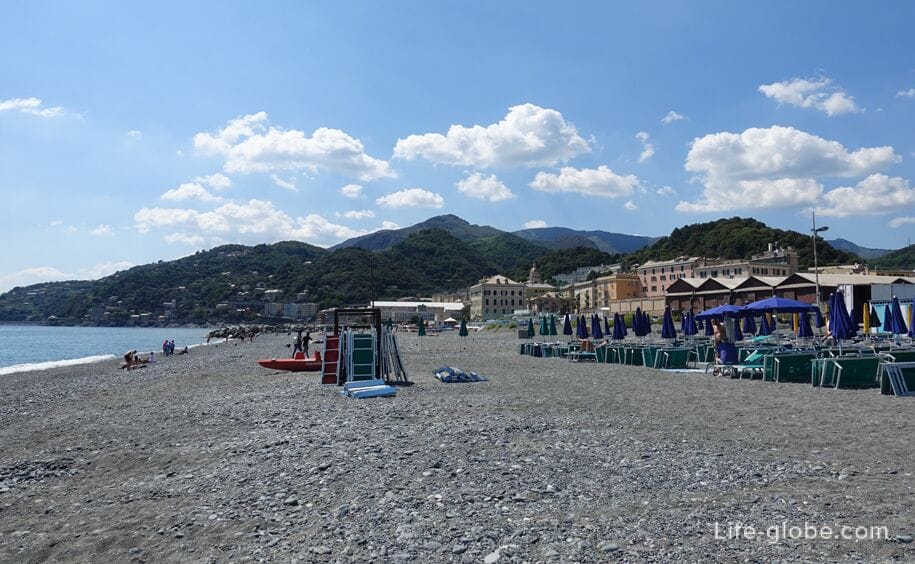


All accommodation facilities in Genoa, including in the city center, near beaches and more remotely from those, can be viewed and booked here